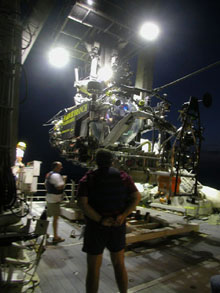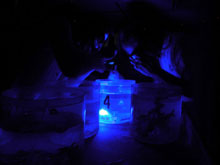
The Johnson-Sea-Link submersible returns from a dive with the Eye-in-the-Sea safely "in tow" on the front. Click image for larger view.

The science crew gathers excitedly to examine recently collected specimens for fluorescence and bioluminescence. Click image for larger view.
Mission Summary
September 4, 2005
Edith Widder, Ph.D.
President and Senior Scientist
Ocean Research and Conservation Association
![]() A Diversity Of Life Clusters In And Around The Lophelia Coral At Vioska Knoll
A Diversity Of Life Clusters In And Around The Lophelia Coral At Vioska Knoll
![]() Some Of The Organisms Living On The Seafloor In The Vioska Knoll Region
Some Of The Organisms Living On The Seafloor In The Vioska Knoll Region
This research cruise has been about light. We have looked at color,
fluorescence, polarization, vision and bioluminescence ![]() ,
all in attempts to explore the nature of light and life in the ocean.
Seeing lights in the ocean - the living lights of bioluminescence observed from
a submersible - is the event that set me on my uncommon career path. I
never imagined that I would become an ocean explorer, but from that first
glimpse of the ocean's living light show there has been no looking back. Today
Cindy Renkas, from NOAA's Office of Ocean Exploration got her first dive
in a submersible. I spoke to her when she emerged and she was vibrating
with excitement at all she had seen, but best of all, she said, was the
bioluminescence. She described it as almost a spiritual experience. It
still thrills me to gain converts to what has become my life's passion. When
I emerged from my first submersible dive 21 years ago, I too was vibrating
with excitement. I was also convinced that bioluminescence had to
be one of the most beautiful and important phenomena in the ocean. It
seemed like it was everywhere and there was so much of it. I simply
couldn't understand why more people weren't studying it. The answer
seemed to be a lack of instrumentation. Although bioluminescence
can look spectacular to the fully dark-adapted human eye, it is quite dim
and difficult to record. Very special instruments are needed. I
have spent most of my career working with engineers to develop those instruments. The
Low Light Auto-Radiometer (LoLAR) and the Eye-In-The-Sea (EITS) that we
have been testing on this cruise are two of those instruments.
,
all in attempts to explore the nature of light and life in the ocean.
Seeing lights in the ocean - the living lights of bioluminescence observed from
a submersible - is the event that set me on my uncommon career path. I
never imagined that I would become an ocean explorer, but from that first
glimpse of the ocean's living light show there has been no looking back. Today
Cindy Renkas, from NOAA's Office of Ocean Exploration got her first dive
in a submersible. I spoke to her when she emerged and she was vibrating
with excitement at all she had seen, but best of all, she said, was the
bioluminescence. She described it as almost a spiritual experience. It
still thrills me to gain converts to what has become my life's passion. When
I emerged from my first submersible dive 21 years ago, I too was vibrating
with excitement. I was also convinced that bioluminescence had to
be one of the most beautiful and important phenomena in the ocean. It
seemed like it was everywhere and there was so much of it. I simply
couldn't understand why more people weren't studying it. The answer
seemed to be a lack of instrumentation. Although bioluminescence
can look spectacular to the fully dark-adapted human eye, it is quite dim
and difficult to record. Very special instruments are needed. I
have spent most of my career working with engineers to develop those instruments. The
Low Light Auto-Radiometer (LoLAR) and the Eye-In-The-Sea (EITS) that we
have been testing on this cruise are two of those instruments.
With every expedition we make improvements to the EITS. One of the big improvements for this expedition is the camera. It is the best I have ever used for bioluminescence recordings and on this trip we have managed to get the illumination just right for being able to view the animals and the bioluminescence at the same time. There is much excitement around the video monitor from my colleagues and graduate students when a large fish, squid or shark swims into view, but I feel equal excitement at every flash of bioluminescence we record. I finally feel like I have the means to unravel some of the ocean's most intriguing bioluminescent mysteries. Now, all we need is more time to explore.
Time to explore doesn't just mean more expeditions. It means time to protect this magnificent frontier so that we can reveal its amazing secrets before they are destroyed. There is a lot of finger-pointing going on right now about the lack of preparedness for Hurricane Katrina. Scientists and engineers warned of the dangers that politicians and policy makers failed to heed. Will they also fail to heed warnings about the deteriorating state of our ocean? Without a healthy ocean we cannot have a healthy planet. It is vital that we act now to protect our ocean. Our future depends upon it.


























